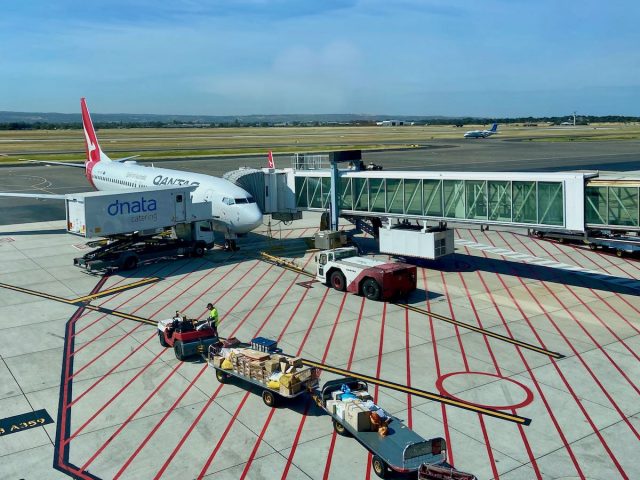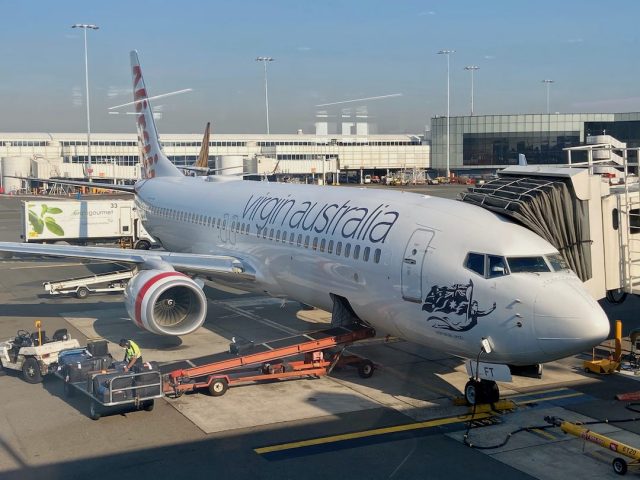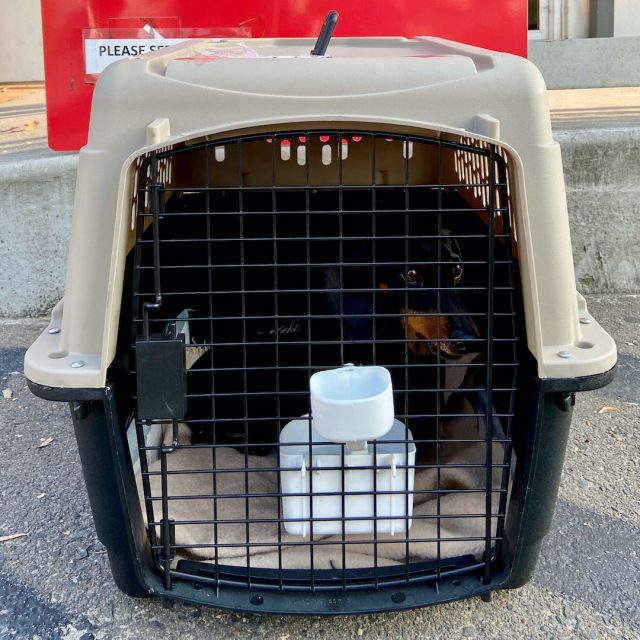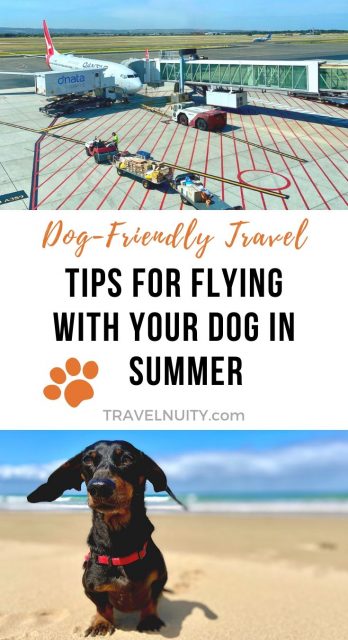If you’re flying with your dog in the cabin during the hot days of summer, there’s no need to worry, as they’ll be in the same air-conditioned comfort as yourself, under your supervision. But if they’re flying in the hold, whether due to size or local regulations (such as in Australia), it’s best to take some precautions to ensure that they stay safe.
The hold in which your pet is flying should be climate-controlled, set to the same temperature as the cabin. (Check with your airline if you’re in doubt. Generally airlines don’t permit dogs to fly in the hold on their aircraft without a temperature-controlled hold.)
The greatest risk for your pet is from when their crate is sitting on the tarmac during loading. For this reason, animals are usually the final thing brought out from the freight depot then loaded onto a plane, but sometimes mistakes can happen, particularly if there are flight delays.
To do everything possible to keep your dog safe during their flight in the hold, follow these tips for flying with a dog in summer.

Are Pets Allowed on Flights During Summer?
In some parts of the world, mainly some of the hotter states of the United States, e.g. Arizona, many airlines have restrictions on transporting pets in the hold over the summer.(There are also sometimes restrictions on flying pets in the hold during winter in colder parts of the world.)
If this could apply to the airport that you are flying from or to, check with your airline in advance if there are temperature restrictions, so that you can look into other options if you must transport your pet, or perhaps decide to not bring your pet along.
Airlines may also just have recommendations on what to do in hot weather, including free re-booking policies for pets.
#1 Book Your Pet on a Flight Early or Late in the Day
If you have to transport your pet during summer, or immediately before or after summer when there is a chance of a heat wave, book your flights for either early morning or late evening. If there’s no curfew on the airport, night time flights are also a good option, assuming the freight office is open.

I find it handy to look at historical temperature information for both your origin and destination airport, with an emphasis on the origin airport, where there’s more likely to be delays. Virgin Australia recommends booking an early morning or evening flight if the temperature is predicted to be above 25C (77F) at either airport.
My preference is for early morning flights. Often the coolest part of the day is around 6:00am or 6:30am. I’d certainly try to get my dog onto a flight before 9:00am.
If considering an evening flight, keep in mind that that on especially hot days, it can stay hot until quite late. Plus if you’re booked on the final flight of the day and it’s cancelled, it’s complicated enough if you’re not travelling with a dog.
#2 Avoid Transit Stops
If the weather is likely to be warm, I would try and not book a flight with a transit stop. Even if both flights are quite short, the impact on your animal from embarking and disembarking on a flight twice on a warm day is a lot more than just once.
Additionally, the facility in which your pet stays in between their flights can differ greatly. Some airports have excellent pet hotels with air-conditioned facilities, while at other it’s likely to be an un-air-conditioned freight terminal. There have also been incidents with dogs where the facilities haven’t matched what has been promised.
Ask whether the transit stop is long enough for you to pick up your animal and look after them in between the flights, checking on their comfort. Alternatively, if you book through a pet transport company, can they pick up the animal and look after them in their own facilities?
Scheduling two flights also makes it more difficult to avoid the heat of the day. Perhaps consider booking a flight that arrives late at night then another one that leaves in the early hours of the morning, particularly if it’s the temperatures of the transit stop that you’re worried about.
We choose this option when we flew our dog from Australia to Spain via Dubai in 2017, when the transit stop was unavoidable. Luckily it was during February, one of their coolest months of the year in Dubai. But we also arrived around midnight then took off around 8:00am.
As part of the service of the pet transport company we booked through, their local agent picked up our dog and took him to the airport kennel in between the flights. He certainly spent a more comfortable night than we did sleeping on chairs at the airport!
#3 Drop Your Pet Off As Late as Possible
The time frame during which you need to drop off your pet to fly in the hold varies depending on the airline, airport and type of flight. When flying my dog domestically in Australia in cargo in 2019, he generally needed to be dropped off before 90 and 120 minutes before the flight. When he flew internationally from Los Angeles to Melbourne in cargo, he needed to be dropped off earlier.
Freight terminals at airports, if your dog is flying as cargo, are generally not air-conditioned. (While some terminals are, such as the terminals in Dubai, this is not common.) The temperatures inside are fine for your pet, but they will stay cooler until closer to the flight if they spend longer in your air-conditioned house or car.
When I was flying my dog on a spring day in Australia that coincided with a heat wave, I was advised when I called the airline to drop him off later rather than earlier (but still within the time window). Dropping your pet off later also means they can take a toilet break later.
#4 Give Your Pet Plenty of Water

It’s a requirement of the crates used to fly dogs in the hold that they have a water dispenser accessible to your pet, that can be filled from outside. Make sure your pet’s crate has one, or even two. Generally I fill it at the last minute, when about to drop off my pet, to minimise spillage.
On warmer days, you may also want to consider putting ice cubes in the dog’s water container, or ice cubes instead of water. This will minimise the issue of spilling, plus keep the water nice and cool for your pup.
#5 Consider Changing Your Dog’s Flight
If the weather for your dog’s flight does end up being hotter than expected, consider the option of changing your dog’s flight. If your dog is scheduled to fly during the middle of the day, consider changing their flight to an earlier one. Perhaps the next day or the previous day will be cooler.
For dogs travelling as cargo, often the ticket rules are a lot more flexible, and it may be possible to change the flight without paying anything extra. For dogs travelling as excess baggage and your own tickets, depending on the ticket category, it might be harder to change your flights without paying extra.
Enquire if it is possible to have someone else pick up your dog at the other end, if they end up on a separate flight. Hopefully the airline is compassionate, but paying extra to change your flights is a small price for keeping your dog safe.
Do not expect the airline or freight company to reach out to you about changing the flight for your pet, even if the temperatures are above their recommendation. Perhaps some companies do this, but this hasn’t happened for me. In the paperwork you sign there will likely be a clause that flying your dog is at your own “discretion” and limiting the responsibility of the airline in such situations.
If your dog is flying with a pet transport company, they should be able to more easily change your dog’s flight, including looking after your dog before or after the flight. If you’re worried about the temperature for your dog’s flight, reach out to them and discuss the options.
Additionally, if you do need to change your pet’s plans due to the weather, it might be useful to contact a pet transport company for assistance, paying extra for the service to keep your dog safe.
#6 Special Recommendations for Brachycephalic Breeds
Brachycephalic, or snub-nosed, breeds, are prone to breathing difficulties and are especially sensitive to hot conditions. (See this typical list of brachycephalic breeds, although the list can vary slightly.)
For this reason, many airlines don’t accept brachycephalic breeds for transport in the hold. If the airline does, they will have extra requirements or recommendations to follow, including in regards to temperature. For example, in Australia, Qantas recommends that these dogs and cats do not fly above 20C (68C).
Carefully consider whether you should fly your dog, and take extra steps to avoid even slightly warm weather. Unfortunately, brachycephalic breeds are overrepresented in fatalities from dogs flying.
#7 Consider Your Dog’s Individual Preferences
Finally, even for other breeds of dogs, their preferences in regards to temperature greatly differ. Generally, smaller dogs with short fur handle higher temperatures better than larger dogs or dogs with thick fur. You would know from your everyday life how your dog handles different temperatures.
For instance, my Miniature Dachshund loves to be a “hot dog”. Even on hot days, he loves to (at least briefly) lie outside in the sun. When we recently experienced a heat wave when he was scheduled to fly on a spring day, part of the reason we decided not to change his flight was because we knew he was fine with the forecast temperatures, at least for brief periods.
For non-brachycephalic dogs, a common guideline is to only fly the dog when temperatures are under 25C (77F). But this can be lower or higher for individual dogs.
A Final Note on Flying with Your Dog in Summer
The flying of dogs in plane holds is a controversial issue, mainly due to the deaths that have periodically occurred, frequently due to high temperatures.
I would love nothing more than for all dogs to be able to fly in the plane cabin, in all parts of the world. But until then, if your dog flies in the hold, I recommend doing everything in your power to make it a safe journey for your dog.
Unfortunately, regardless of the airline’s reputation, sometimes pets aren’t looked after properly, whether due to mistakes or poor practises. Don’t rely solely on the airline to care for your pet, but minimise the risk of harm to your pet if case a mistake does happen.
Finally, keep in mind that many animals are flown every day as cargo or excess baggage in the hold, mainly without incident.
You May Also Like
- Flying with a Dog: The Ultimate Guide
- 25 Top Tips for Flying with a Dog
- Flying with a Dog in Australia
About the Author

Shandos Cleaver is the founder of Travelnuity: Dog-Friendly Travel. She has travelled extensively with her Miniature Dachshund, Schnitzel, including to 33 countries across Europe, every state and territory of Australia except Tasmania, and 10 of the United States. She’s passionate about providing inspiration and information to others wanting to travel with their dogs, whether close to home or internationally.
Inspired? Pin this to your Pinterest board!


These are some great tips to bring your dog along on the plane. It’s a relief to know that the pets are getting great care on the way to vacation.
Thanks Jorge!
Thank you for this invaluable article! Do you recommend giving dogs anti-anxiety medication before checking them into the cargo hold?
I recommend speaking to your vet and considering your dog’s reactions. Also, always test it out in advance. Sedation is highly unrecommended but other medication may be fine.
Thanks for such an informative article!
We are planning to move from CA back to Australia soon with our two maltipoos. What time of the year do you suggest we fly since the seasons are opposite? When did you fly back to Australia with Schnitzel?
I flew back to Australia with Schnitzel in early December. It wasn’t the best time weather wise, as I was concerned about the heat on the day he landed, but we didn’t have much flexibility. (Also note that the quarantine usually doesn’t accept new dogs for a week or two over Christmas.) I recommend aiming for spring/fall.